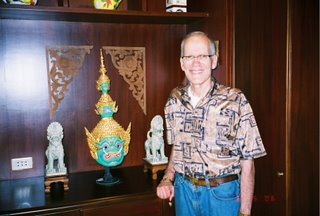 |
|
The
interior of the Thermae Berzieri in Salsomaggiore, Italy, is decorated with
Galileo Chini's art, which is on display at the Siam Paragon.
| |
Siam Paragon. Bangkok, Thailand. September 18, 2013. A lot of buildings
are being constructed today, especially in the part of the world in which I
live, but few of them are beautiful. The
emphasis in architecture since about the 1920’s has been on form and functionality. Beauty has taken a back seat. Decoration is mostly non-existent having been
replaced by glass and steel, ease of installation, control of buildings
costs. Anything non-essential is an
unaffordable frill, wasteful, and not part of the developers plans. Buyers and renters demand “affordability,”
that is, something as cheap as possible, art, distinction and beauty be dammed.
A magnificent exhibit at the Siam Paragon reminded me that
this was not always the case. In fact, a
look at almost any building 75 years old or older, in any city of the world, is
a reminder that there was a time when decoration and style were a normal part
of the building process, and for that reason, tourists flock to the old parts
of cities like Florence, Paris, London, Tokyo, Bangkok.
Galileo Chini (1873-1956), of whom I had never heard before
this exhibit, was an Italian decorator, designer, painter, and potter, who,
beginning around 1900, became famous, mostly for his ceramics. He was part of the Art Noveau movement,
which, I think, would include Gaudi in Barcelona. Amazingly, Chini painted the fresco in the
dome of Bangkok’s ornate and very beautiful Anata Samakhom Throne Hall. This exhibit, entitled “Galileo Chini: The
Jewels of Decorations,” displays 26 of
Chini’s ceramics as works of art, which indeed they are, but it is important to
note that originally they were building blocks (construction materials) of a
thermal spa in Salsomaggiore, Italy, where they comprised parts of the walls,
stairs, cornices, facings, etc. In fact,
the ceramics on display were only recently discovered in the basement of the
spa, where they were stored 90 years ago to be used as back-up pieces.
There is a museum devoted to Galileo Chini near Florence, Italy. Now that I’ve been introduced to Chini’s
stunningly beautiful art, I will be sure to visit it on my next trip to Italy.
 |
|
Ceramic brick for external decoration. |
 |
|
Moulding for architectural decoration. |
 |
|
Flower with stem. |
 |
| Ornamental piece in amphora form. |
 |
|
Element for architectural decoration. Angle piece. |
 |
|
Cylinder shape molding for external architectural
decoration.
|
 |
|
Element for external architectural decoration. Composition for pilaster façade. |
 |
| Umbrella stand. |
 |
|
Contemporary Thai artist, Maitree Siriboon from Ubon
Ratchathani. was inspired by Chini to create this elaborate mosaic.
 |
|
The Chini exhibit was a joint undertaking of the Embassy of
Italy and the Siam Paragon.
|
|














0 Comments:
Post a Comment
<< Home